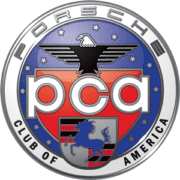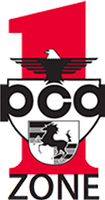THE CAR – Autocross – October 2011
Well, here comes the slippery slope. As soon as the average driver begins to learn their way around the course and their car control skills begin to improve – guess what happens next? How can the car be improved as I am surely being held back by my car….. Let’s forget the seat time, experience factors for the moment and focus on sliding down the absolutely justified slippery slope of car improvements. While some of these improvements really are justified and really do help, other modifications may not actually help and may even hinder improvement. This article will cover some of the more basic (and less costly) improvements and future articles will cover items to add to your Holiday wish list.
The most basic and least expensive changes that are available to all Autocrossers are tire pressure and alignment. The other two most common improvements yet cost some bucks are adjustable sway bars and adjustable shocks (height and damping). If you are new to Autocross, these are often not too expensive, very effective at changing the car’s handling and easy to adjust as conditions change.
Tires and Pressure: In the end, the tires play a big role and are the only part of the car touching the pavement. They take care of starting, stopping and turning the car. Tires are actually very complex and highly engineered. The way a tire behaves is dependent upon many factors; quality and formulation of the tire, the wheel to which it is mounted and car alignment. Tires do their best job only when conditions are right and can work poorly for any one of a number of reasons. Once a tire is selected and mounted, generally the one thing the Autocrosser can adjust is air pressure. How do you decide what air pressure to run? Unless someone with the same/similar car, modifications and setup has experience with a particular tire, you must rely on trial and error and learn from the tire’s behavior on course. Air pressure that is too low results in a tire that deflects badly while under cornering loads and pressure that is too high results in rock hard tires that refuse to grip the pavement. I will not go into the various street versus R-Comp tire factors/issues here, but suffice it to say that High Performance tires whether street or R-comp should be your weapon of choice for Autocrossing (meaning avoid snows, run flats or lower performance tires for competition). Regardless of the tires you pick, until some testing has been done in an Autocross environment, tire pressure should be set near the manufacturer’s recommendation, and then the pressure can be adjusted based on what the tire is telling you.
Tires talk? You bet they do and they even sing if pushed hard enough. A tire works most efficiently when the entire tread is pushed into the pavement with an even pressure. You can tell how evenly a tire is working by how it wears. An easy test to check proper pressure, is to put white shoe polish or chalk on the outside shoulder of the tire. If after a run the white is gone, the tire is not holding its shape during a turn and likely needs more air. If there is white still on the outer tread, the outside edge is probably not being used at all and you should try lowering the tire pressure to help it grab the pavement better. The “perfect” tire pressure via this method will be found when the white is worn away to the edge of the tread, but the white on the sidewall is still intact. This is a crude but very effective way to determine the optimum tire pressure (and during an event as well). There are more advanced techniques for determining the optimum tire pressure, but these require a special tool called a pyrometer. There could be an entire article on tires but we need to move on to Alignment.
Alignment: No we are not going to talk about whether your head is on straight and if you need an attitude adjustment, we will cover your car’s suspension. We discussed that tires are most efficient when they are pressed evenly into the pavement. While air pressure is a factor, a bigger factor is how the car’s suspension is aligned. Alignment effects how a tire is loaded – the alignment determines how the wheels/tires are tilted relative to the pavement. Without changing the cars suspension parts, there are generally three alignment settings; camber caster and toe.
Camber: Most modern cars have some camber adjustability. High performance cars may even have enough camber adjustability with stock components but do not count on it. Camber is very important to a car’s performance on an Autocross course and has a significant impact to how well a tire performs. Increasing negative static camber often improves cornering performance. Running near static zero camber is generally most efficient for pure acceleration and braking. Camber is yet another compromise in performance. The right amount of static camber is dependent upon many factors related to the car, tires and road surface. There is much to cover if we venture into the world of a car’s suspension geometry, tire characteristics from one model to another, etc…… In the most basic form, camber can be used in two different ways: to adjust a car’s balance in a corner and to add or remove grip. For the understeering car, front grip should be added. To do this, change the camber so that the entire tire is worked evenly in the corner. This will mean adding camber, but not always. After front grip has been adjusted as well as possible, and if understeer is still present, it is possible to remove rear grip by intentionally making the rear tires less efficient. This can be accomplished via a rear camber adjustment (more positive) or an adjustment in tire pressure (higher).
Caster: This is not commonly adjustable on stock automobiles. Changing caster modifies how much a change in camber is realized when the steering wheel is turned. Please contact your automotive professional for a deep discussion on this topic (sorry).
Toe: For the moment, let us forget the definition of toe. Toe does one thing: adjusts the stability of the car. Toe-in is where the front part of the tires point toward each other and makes that axle more stable. Toe-out gives you the opposite. Physically changing toe changes the slip angle of the tires making them more or less efficient. Front toe affects how darty a car feels. A car with toe-in allows a driver to move the steering wheel away from center without really changing the direction of travel. A car with toe-out tries to change directions quickly. On the highway, toe-out is generally discouraged as the car tends to follow every rut and changes lanes on a whim, generally requiring constant attention while driving. On an Autocross course, you are trying to change directions quickly and would likely appreciate a bit of toe-out. This requires more attention but can be very effective. Please be careful if your Autocross car is also your daily driver. Rear toe affects how well the back of the car follows the front. Rear toe-in makes the rear of the car more stable as does visa-versa.
Well, that’s it for now. In a future article, we will cover sway bars and their adjustment as well as shocks.
Thanks to Andrew Howe in his support of this article.


